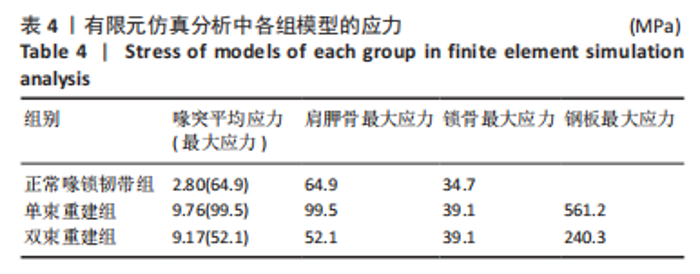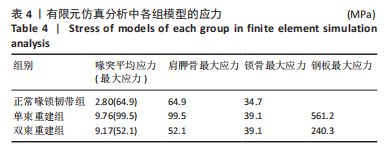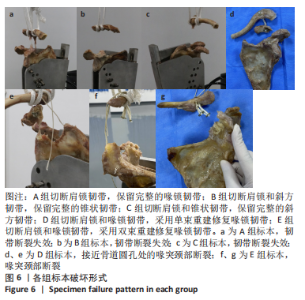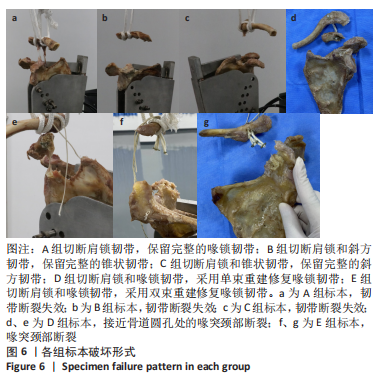Chinese Journal of Tissue Engineering Research ›› 2024, Vol. 28 ›› Issue (5): 706-711.doi: 10.12307/2024.262
Previous Articles Next Articles
Finite element simulation and experimental test of normal coracoclavicular ligament and flexible reconstruction
Ji Guizhu1, 2, Zheng Qiu3, Wang Wuxiang1, Wang Guan1, 2, Li Wen1, Lu Xiaobo1, 2, Duan Ke1, 2, Li Zhong1, 2, Yang Hongbin1, 2, Liang Cheng1, 2, 4
- 1Department of Orthopedics, 4Clinical Medicine Research Center, Affiliated Hospital of Southwest Medical University, Luzhou 646000, Sichuan Province, China; 2Sichuan Provincial Laboratory of Orthopedic Engineering, Southwest Medical University, Luzhou 646000, Sichuan Province, China; 3Department of Orthopedics, Affiliated Traditional Chinese Medicine Hospital of Southwest Medical University, Luzhou 646000, Sichuan Province, China
-
Received:2023-03-10Accepted:2023-04-20Online:2024-02-18Published:2023-08-16 -
Contact:Yang Hongbin, Chief physician, Department of Orthopedics, Affiliated Hospital of Southwest Medical University, Luzhou 646000, Sichuan Province, China; Sichuan Provincial Laboratory of Orthopedic Engineering, Southwest Medical University, Luzhou 646000, Sichuan Province, China Liang Cheng, Engineer, Department of Orthopedics, and Clinical Medicine Research Center, Affiliated Hospital of Southwest Medical University, Luzhou 646000, Sichuan Province, China; Sichuan Provincial Laboratory of Orthopedic Engineering, Southwest Medical University, Luzhou 646000, Sichuan Province, China -
About author:Ji Guizhu, Master, Physician, Department of Orthopedics, Affiliated Hospital of Southwest Medical University, Luzhou 646000, Sichuan Province, China; Sichuan Provincial Laboratory of Orthopedic Engineering, Southwest Medical University, Luzhou 646000, Sichuan Province, China -
Supported by:Luzhou-Southwest Medical University Cooperation Project, No. 2020LZXNYDF02 (to WG); Luxian-Southwest Medical University Cooperation Project, No. 2020LXXNYKD-01 (to LXB)
CLC Number:
Cite this article
Ji Guizhu, Zheng Qiu, Wang Wuxiang, Wang Guan, Li Wen, Lu Xiaobo, Duan Ke, Li Zhong, Yang Hongbin, Liang Cheng. Finite element simulation and experimental test of normal coracoclavicular ligament and flexible reconstruction[J]. Chinese Journal of Tissue Engineering Research, 2024, 28(5): 706-711.
share this article
Add to citation manager EndNote|Reference Manager|ProCite|BibTeX|RefWorks
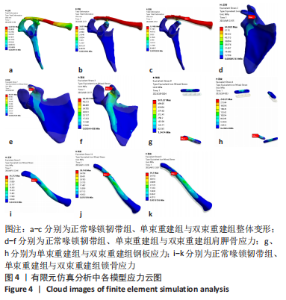
正常喙锁韧带连接中,锁骨和肩胛骨变形均匀变化,从外侧到中段锁骨变形连续增加,中段到内侧锁骨变形均匀减小(图4a);单束重建和双束重建后锁骨变形明显,锁骨变形一致,变形局部集中(图4b、c);正常喙锁韧带连接肩胛骨的大应力范围相对较小(图4d);单束重建组肩胛骨最大应力最大,且大应力范围最大(图4e);双束重建组肩胛骨最大应力最小,大应力范围相对适中(图4f),该结果显示喙锁韧带原生韧带具备优良的变形抵抗能力,而单束重建和双束重建较弱。单束重建钢板最大应力最大,双束重建钢板最大应力为其42.8%(图4g、h),在钢板均承受载荷的情况下增加钢板数量能降低钢板应力,分散传递外力。分析结果和常识符合,一定程度上说明仿真的有效性。对3组分析,锁骨应力云图分布接近,锁骨最大应力接近,均远小于肩胛骨最大应力(图4i-k)。单束重建钢板最大应力最大,双束重建钢板最大应力为其42.8%,在钢板均承受载荷的情况下增加钢板数量能降低钢板应力,分散传递外力。"
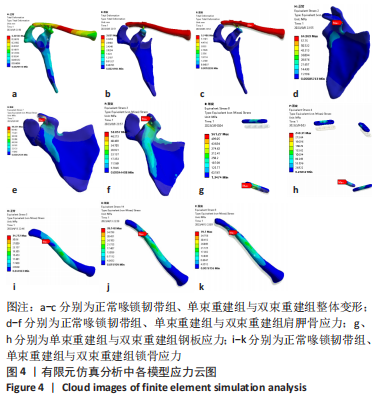
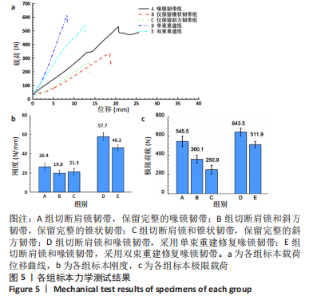
2.2 标本实验结果 根据实验测试数据绘制各标本的载荷位移曲线(图5a),计算各标本组刚度(图5b)和极限载荷(图5c)。A-E组标本的刚度分别为(26.4±3.5),(19.8±2.8),(21.3±3.2),(57.7±4.1),(46.2±2.8) N/mm,极限载荷分别为(545.5±53.7),(360.1±42.1),(250.9±44.4),(643.5±39.1),(511.9±31.7) N,其中,D组标本的刚度和极限承载最大,E组标本的刚度与D组接近、极限载荷与A组接近。D、E组标本的整体刚度高于A组(P=0.000 06,0.000 3),D组极限承载高于A组(P < 0.05),E组标本的极限载荷和A组比较无明显差异(P > 0.05)。总体来说,单束和双束重建组标本的最大承载能力高于或接近正常喙锁韧带,满足使用要求。 "
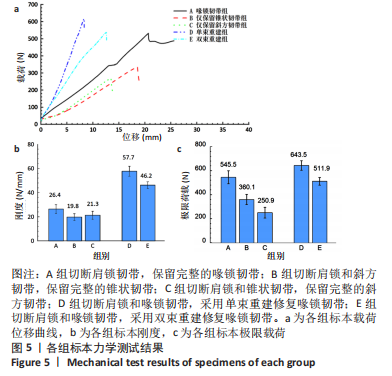
| [1] KIM AC, MATCUK G, PATEL D, et al. Acromioclavicular joint injuries and reconstructions: a review of expected imaging findings and potential complications. Emerg Radiol. 2012; 19(5):399-413. [2] HU F, HAN S, LIU F, et al. A modified single-endobutton technique combined with nice knot for treatment of Rockwood type III or V acromioclavicular joint dislocation. BMC Musculoskel Dis. 2022;23(1):15. [3] 彭明学,钱亮,孙策勇.双股钢丝袢喙锁间固定治疗TossyⅢ型肩锁关节脱位[J].四川医学,2011,32(7):1122-1123. [4] SUNDARAM N, PATEL DV, PORTER DS. Stabilization of acute acromioclavicular dislocation by a modified Bosworth technique: a long-term follow-up study. Injury. 1992;23(3):189-193. [5] LEE SJ, EOM TW, HYUN YS. Complications and Frequency of Surgical Treatment with AO-Type Hook Plate in Shoulder Trauma: A Retrospective Study. J Clin Med. 2022;11(4):1026. [6] CHEN CH, DONG QR, ZHOU RK, et al. Effects of hook plate on shoulder function after treatment of acromioclavicular joint dislocation. Int J Clin Exp Med. 2014;7(9):2564-2570. [7] ARIRACHAKARAN A, BOONARD M, PIYAPITTAYANUN P, et al. Post-operative outcomes and complications of suspensory loop fixation device versus hook plate in acute unstable acromioclavicular joint dislocation: a systematic review and meta-analysis. J Orthop Traumatol. 2017;18(4):293-304. [8] HUANG D, HU Z, FENG W, et al. Dual plate has better biomechanical stability than hook plate or superior single plate for the fixation of unstable distal clavicle fractures: a finite element analysis. Arch Orthop Traum Surg. 2023. doi: 10.1007/s00402-023-04801-5. [9] PARK I, LEE S, SHIN SJ. Arthroscopic-Assisted Double-Bundle Coracoclavicular Ligament Reconstruction Using Cortical Fixation Buttons With Suture Tape Provides Superior Vertical Stability Than the Single-Bundle Reconstruction for Acute Acromioclavicular Joint Dislocation. Arthroscopy. 2023;39(2):213-221. [10] XUE C, SONG L, ZHENG X, et al. Truly anatomic coracoclavicular ligament reconstruction with 2 EndoButton devices for acute Rockwood type V acromioclavicular joint dislocations: 5-year findings. J Shoulder Elbow Surg. 2022;31(4):855-859. [11] JIANG H, TONG J, SHEN L, et al. Clinical Outcomes of Arthroscopy-Assisted Modified Triple Endobutton Plate Fixation in Rockwood Type III Acute Acromioclavicular Joint Dislocation: A Retrospective Study. Orthop Surg. 2022;14(10):2436-2446. [12] STRUHL S, WOLFSON TS. Continuous Loop Double Endobutton Reconstruction for Acromioclavicular Joint Dislocation. Am J Sports Med. 2015;43(10):2437-2444. [13] HAN XD, DENG B, MENG XB, et al. Case-control study on the Endobutton plate and clavicular hook plate for the treatment of acromioclavicular joint dislocation. Zhongguo gu Shang. 2021;34(12):1152-1157. [14] LI S, WANG S, LIU W, et al. Current strategies for enhancement of the bioactivity of artificial ligaments: A mini-review. J Orthop Translat. 2022;36:205-215. [15] SELLARDS R. Anatomy and biomechanics of the acromioclavicular joint. Oper Techn Sports Med. 2004;12(1):2-5. [16] MARCHESE RM, BORDONI B. Anatomy, shoulder and upper limb, coracoclavicular joint (coracoclavicular ligament)//StatPearls [Internet]. StatPearls Publishing, 2021. [17] BONTEMPO NA, MAZZOCCA AD. Biomechanics and treatment of acromioclavicular and sternoclavicular joint injuries. Br J Sports Med. 2010;44(5):361-369. [18] ALLAHABADI S, CHAHLA J. Editorial Commentary: Coracoclavicular Joint Reconstruction for Acromioclavicular Dislocation: Double-Bundle Techniques Are Anatomically and Biomechanically Favored. Arthroscopy. 2023;39(2):222-224. [19] ÇARKÇı E, POLAT AE, GÜRPıNAR T. The frequency of reduction loss after arthroscopic fixation of acute acromioclavicular dislocations using a double-button device, and its effect on clinical and radiological results. J Orthop Surg Res. 2020;15(1):136. [20] PARK I, ITAMI Y, HEDAYATI B, et al. Biomechanical Analysis of Single-, Double-, and Triple-Bundle Configurations for Coracoclavicular Ligament Reconstruction Using Cortical Fixation Buttons With Suture Tapes: A Cadaveric Study. Arthroscopy. 2018;34(11):2983-2991. [21] FUKUDA K, CRAIG E, AN KN, et al. Biomechanical study of the ligamentous system of the acromioclavicular joint. J Bone Joint Surg. 1986;68(3):434-440. [22] DEBSKI RE, PARSONS IM, WOO SLY, et al. Effect of capsular injury on acromioclavicular joint mechanics. J Bone Joint Surg. 2001;83(9):1344-1351. [23] SALTER EG JR, NASCA RJ, SHELLEY BS. Anatomical observations on the acromioclavicular joint and supporting ligaments. Am J Sports Med. 1987;15(3):199-206. [24] HARRIS RI, WALLACE AL, HARPER GD, et al. Structural properties of the intact and the reconstructed coracoclavicular ligament complex. Am J Sports Med. 2000;28(1):103-108. [25] 焦开刚,范建楠.三扣技术与双扣技术重建肩锁关节脱位的生物力学比较[J].生物骨科材料与临床研究,2021,18(6):7-12. [26] VELASQUEZ GARCIA A, SALAMÉ F, MURA J. The stress and strain pattern in the ligaments of the acromioclavicular joint using a quasi-static model. Clin Biomech (Bristol, Avon). 2023;101:105859. [27] CIVAN O, ATMACA H, UĞUR L. Biomechanical comparison of double versus triple button reconstruction techniques in patients with acromioclavicular joint dislocation. Int J Med Robot. 2020;16(1):e2057. [28] SUMANONT S, NOPAMASSIRI S, BOONROD A, et al. Acromioclavicular joint dislocation: a Dog Bone button fixation alone versus Dog Bone button fixation augmented with acromioclavicular repair-a finite element analysis study. Eur J Orthop Surg Traumatol. 2018;28(6):1095-1101. [29] LIU J, GAO Y, NIU B, et al. Biomechanical analysis of a novel clavicular hook plate for the treatment of acromioclavicular joint dislocation: A finite element analysis. Comput Biol Med. 2021;133:104379. [30] WALZ L, SALZMANN GM, FABBRO T, et al. The Anatomic Reconstruction of Acromioclavicular Joint Dislocations Using 2 TightRope Devices: A Biomechanical Study. Am J Sports Med. 2008;36(12):2398-2406. [31] COSTIC RS, LABRIOLA JE, RODOSKY MW, et al. Biomechanical Rationale for Development of Anatomical Reconstructions of Coracoclavicular Ligaments after Complete Acromioclavicular Joint Dislocations. Am J Sports Med. 2004;32(8):1929-1936. [32] GRUTTER PW, PETERSEN SA. Anatomical acromioclavicular ligament reconstruction: a biomechanical comparison of reconstructive techniques of the acromioclavicular joint. Am J Sports Med. 2005;33(11):1723-1728. [33] KLASSEN JF, MORREY BF, AN KN. Surgical anatomy and functionof the acromioclavicular and coracoclavicular ligaments. Oper Techn Sport Med. 1997;5(2):60-64. [34] Hislop P, Sakata K, Ackland DC, et al. Acromioclavicular Joint Stabilization: A Biomechanical Study of Bidirectional Stability and Strength. Orthop J Sports Med. 2019;7(4):2325967119836751. [35] SONG Z, WANG C, YANG N, et al. Biomechanical Study on the Treatment of Acromioclavicular Joint Dislocation by Coracoclavicular Ligament Reconstruction With a Novel EndoButton Plate Combined With Suture Anchor. 2021. doi:10.21203/rs.3.rs-570889/v1 [36] GRANTHAM C, HECKMANN N, WANG L, et al. A biomechanical assessment of a novel double endobutton technique versus a coracoid cerclage sling for acromioclavicular and coracoclavicular injuries. Knee Surg Sports Traumatol Arthrosc. 2016;24:1918-1924. [37] LI Q, HSUEH PL, CHEN YF. Coracoclavicular ligament reconstruction: a systematic review and a biomechanical study of a triple endobutton technique. Medicine (Baltimore). 2014; 93(28):e193. [38] ZHANG L, HE A, JIN Y, et al. Novel Double Endobutton Technique Combined with Three‐Dimensional Printing: A Biomechanical Study of Reconstruction in Acromioclavicular Joint Dislocation. Orthop Surg. 2020;12(5):1511-1519. [39] GAO R, ZHANG W, YANG Y, et al. Evaluation of the coracoid bone tunnel placement on Dog Bone™ button fixation for acromioclavicular joint dislocation: a cadaver study combined with finite element analysis. BMC Musculoskel Dis. 2023;24(1):18. [40] 房燚,赵文志,潘德悦,等.肩锁关节脱位研究:如何达到解剖复位和持续性稳定及关节微动[J].中国组织工程研究,2020,24(5):796-802. [41] EID AA, MOSTAFA IA, SHWITTER L. Evaluation of Adjustable Loop Fixation in Management of Acute Acromioclavicular Joint Dislocation. Int J Med Art. 2022;4(8):2570-2577. [42] 刘凡凡,刘朝阳,徐毅,等.可调悬吊钛板微创治疗完全性肩锁关节脱位的疗效[J].实用骨科杂志,2018,24(11):1022-1024. [43] TEODORO RL, NISHIMI AY, PASCARELLI L, et al. Surgical treatment of acromioclavicular dislocation using the endobutton. Acta Ortop Bras. 2017;25:81-84. [44] 陈羽,宋烜,陆骅等.喙锁韧带重建中锁骨钻孔位置的数字解剖学[J].中国组织工程研究,2015,19(42):6759-6763. |
| [1] | Weng Rui, Lin Dongxin, Guo Haiwei, Zhang Wensheng, Song Yuke, Lin Hongheng, Li Wenchao, Ye Linqiang. Abnormal types of intervertebral disc structure and related mechanical loading with biomechanical factors [J]. Chinese Journal of Tissue Engineering Research, 2024, 28(9): 1436-1442. |
| [2] | Li Zhifei, Yang Yin, Chen Hualong, Liang Qinqiu, Zhong Yuanming, Zhang Yisheng. Finite element analysis of the correlation between tilt angle of titanium cage and postoperative subsidence of titanium cage after anterior subtotal cervical corpectomy, decompression and fusion [J]. Chinese Journal of Tissue Engineering Research, 2024, 28(9): 1313-1319. |
| [3] | Chen Mengmeng, Bao Li, Chen Hao, Jia Pu, Feng Fei, Shi Guan, Tang Hai. Biomechanical characteristics of a novel interspinous distraction fusion device BacFuse for the repair of lumbar degenerative disease [J]. Chinese Journal of Tissue Engineering Research, 2024, 28(9): 1325-1329. |
| [4] | Liang Cheng, Zhang Linqi, Wang Guan, Li Wen, Duan Ke, Li Zhong, Lu Xiaobo, Zhuo Naiqiang. Finite element and biomechanical analysis of different implants in repair for unilateral unstable pelvic posterior ring injury [J]. Chinese Journal of Tissue Engineering Research, 2024, 28(9): 1336-1341. |
| [5] | Yang Junliang, Lu Tan, Xu Biao, Jiang Yaqiong, Wang Fucheng. Three-dimensional finite element analysis of effects of partial anterior cruciate ligament rupture on knee joint stress [J]. Chinese Journal of Tissue Engineering Research, 2024, 28(9): 1347-1353. |
| [6] | Xiaheida·Yilaerjiang, Nijiati·Tuerxun, Reyila·Kuerban, Baibujiafu·Yelisi, Chen Xin. Three-dimensional finite element analysis of the distribution pattern of stress in bone tissues with different characteristics [J]. Chinese Journal of Tissue Engineering Research, 2024, 28(8): 1277-1282. |
| [7] | Wang Qiang, Li Shiyun, Xiong Ying, Li Tiantian. Biomechanical changes of the cervical spine in internal fixation with different anterior cervical interbody fusion systems [J]. Chinese Journal of Tissue Engineering Research, 2024, 28(6): 821-826. |
| [8] | Wei Yuanbiao, Lin Zhan, Chen Yanmei, Yang Tenghui, Zhao Xiao, Chen Yangsheng, Zhou Yanhui, Yang Minchao, Huang Feiqi. Finite element analysis of effects of sagittal cervical manipulation on intervertebral disc and facet joints [J]. Chinese Journal of Tissue Engineering Research, 2024, 28(6): 827-832. |
| [9] | Zhang Rui, Wang Kun, Shen Zicong, Mao Lu, Wu Xiaotao. Effects of endoscopic foraminoplasty and laminoplasty on biomechanical properties of intervertebral disc and isthmus [J]. Chinese Journal of Tissue Engineering Research, 2024, 28(6): 833-839. |
| [10] | Kang Zhijie, Cao Zhenhua, Xu Yangyang, Zhang Yunfeng, Jin Feng, Su Baoke, Wang Lidong, Tong Ling, Liu Qinghua, Fang Yuan, Sha Lirong, Liang Liang, Li Mengmeng, Du Yifei, Lin Lin, Wang Haiyan, Li Xiaohe, Li Zhijun. Finite element model establishment and stress analysis of lumbar-sacral intervertebral disc in ankylosing spondylitis [J]. Chinese Journal of Tissue Engineering Research, 2024, 28(6): 840-846. |
| [11] | Zhang Min, Peng Jing, Zhang Qiang, Chen Dewang. Mechanical properties of L3/4 laminar decompression and intervertebral fusion in elderly osteoporosis patients analyzed by finite element method [J]. Chinese Journal of Tissue Engineering Research, 2024, 28(6): 847-851. |
| [12] | Xue Xiaofeng, Wei Yongkang, Qiao Xiaohong, Du Yuyong, Niu Jianjun, Ren Lixin, Yang Huifeng, Zhang Zhimin, Guo Yuan, Chen Weiyi. Finite element analysis of osteoporosis in proximal femur after cannulated screw fixation for femoral neck fracture [J]. Chinese Journal of Tissue Engineering Research, 2024, 28(6): 862-867. |
| [13] | Huang Peizhen, Dong Hang, Cai Qunbin, Lin Ziling, Huang Feng. Finite element analysis of anterograde and retrograde intramedullary nail for different areas of femoral shaft fractures [J]. Chinese Journal of Tissue Engineering Research, 2024, 28(6): 868-872. |
| [14] | Wang Mingming, Zhang Zhong, Sun Jianhua, Zhao Gang, Song Hua, Yan Huadong, Lyu Bin. Finite element analysis of three different minimally invasive fixation methods for distal tibial fractures with soft tissue injury [J]. Chinese Journal of Tissue Engineering Research, 2024, 28(6): 879-885. |
| [15] | Hou Zexin, Xu Benke, Dai Yuan, He Chuan, Zhang Chaoju, Li Xiaolin. Finite element analysis of the mechanism of dorsiflexion injury of wrist joint in elderly people after falls [J]. Chinese Journal of Tissue Engineering Research, 2024, 28(6): 886-890. |
| Viewed | ||||||
|
Full text |
|
|||||
|
Abstract |
|
|||||
